Wall paint vs. wallpaper: which is a better option for your commercial property?
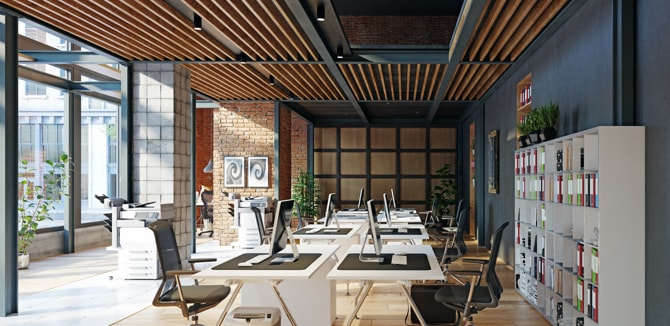
With wallpaper once again enjoying some time in the limelight, more and more questions come our way at Painters Inc. about paint vs. wallpaper – which one is better? We know how different one customer’s preferences can be compared to the next one, which is why there is no dead set correct answer for the question regarding which one is better, but there are situations where it might be more beneficial to choose paint simply because of environmental factors in a property.
At Painters Inc., we are professional painters, but we also assist our customers with all types of wall coverings, including wallpaper. We can help guide you to the right decision, the one that will be right not only for your tastes, but for your facility.
Paints in commercial buildings, warehouses & facility interiors
At Painters Inc., we know that each individual building has specific needs, which is why we will choose the perfect paint for your facility, whether it’s an office building, warehouse or an industrial facility – any type of commercial facility – we have the knowledge regarding interior painting techniques, the right brands of paints to use and every aspect of a commercial painting job that will produce professional results.
From high traffic areas to a cubical office setting, there is a right paint and a wrong paint to use. Rather than going through an expensive trial and error process, choose the right painting contractor and see immediate results.
Wallpapers in your commercial interior design
If you’re looking for something to give your commercial space an added bit of style, wallpaper might do the trick. When you choose the right color/pattern, you can cover your goals for functionality and also tend to your unique sense of taste that gives your commercial property the panache that impresses customers.
The difference between residential wallpaper and the product professionals install in commercial properties is that the residential paper is often quite a bit thinner than the paper we install for commercial clients. Public spaces often get more traffic, so the paper has to be more durable. Due to the more rigorous construction standards, you’ll find that there are fewer options in patterns than you see with residential wallpaper, but there is still plenty to choose from.
Key factors to consider when deciding between painting and wallpaper
If you’re on the fence about which to choose – paint or wallpaper – you’re not alone. Many of our customers at Painters Inc. come to us somewhere in the middle and need some assistance to feel confident they’re making the right decision.
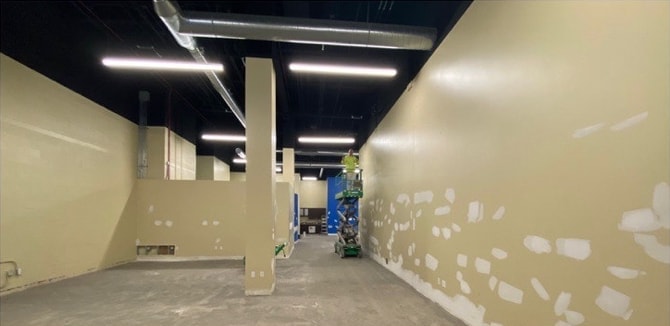
Fortunately, there are some key factors you can consider that will help you come to that decision. In some cases it comes down to the amount of prep work it takes to get a job started.
Check out the following to figure out which is best for you:
Wall surface preparation: which method requires more preparation?
Downtime is a major disruptor for commercial properties that need to be open to do business. Downtime can completely alter what seemed like a solid plan from the outset. For example, if your project involves removing old wallpaper, which is a time-intensive task, you need to consider this before you move forward.
But it’s not only wallpapering that requires extensive prepwork. If you plan on painting your property but there are numerous areas that need to be repaired before primer and paint can be applied, you’re also going to have to factor that into your timeline. When it comes to which process takes longer – preparing walls for paint or for wallpaper – it almost always takes longer to prep walls for paper.
Wall preparation for painting
Depending on the condition of your walls, the preparation carried out prior to painting can include everything from filling in small nail holes to repairing large holes and missing drywall. It can include a cold water or hot water wash or even ice blasting if there is a significant buildup of organic material. Some jobs require the use of a solvent to wash off grease and grime, and other jobs will require sandblasting.
Professional painters will also ensure that all electrical conduits and control boxes are not exposed during the prep process and all areas that could potentially be splattered with cleaning solution or paint are covered before the prep work and painting begins. At Painters Inc., we take the preparation process extremely seriously.
Wall preparation for wallcovering
Before beginning a wallcovering project, most contractors will take great pains to ensure the surfaces are ready for application. This can include removing all switch plates and outlet plates, wall fixtures and any type of electrical obstacle. The surfaces must be clean and dry to ensure that there are no holes, dents or imperfections. If there is glossy or semi-gloss paint on the surfaces, they will need to be sanded/dulled to ensure the paper adheres properly.
Newly installed drywall will need to be wiped clean of dust for proper adhesion. The most important part of preparing for wallpaper is making sure the surface is clean and is structurally sound enough to accommodate the paper, which shrinks and contracts when it cures, putting stress on the walls. Your contractor will need to be especially diligent to these tasks before papering.
So, which one takes more time and effort? That really depends on the condition of the surfaces. However, all things being equal, there is usually more labor involved with preparing walls for wallpaper.
Appearance and variety options
One thing you don’t have to worry about when choosing paint or wallpaper is that there are many, many options in styles and colors for either. In most situations it’s a taste preference. However, your choice might also be dictated by the space you’re in. For example, if your space feels a bit cramped, you might opt for paint because utilizing the right tone of paint can make a space feel larger than it actually is. This is more difficult to achieve with wallpaper.
Fortunately, your choice in colors is almost limitless in paint and wallpaper, so if getting the right hue is important, you should be covered. You also must consider the sheen of your paint, which can be controlled by the amount of gloss in it. Similarly, wallpaper comes in vinyl, which can also provide that sheen you’re looking for.
Paint types and finishes
Given the dyes available today, your imagination is the only limit to what colors you can choose. But there is more than just color to consider. Let’s run through the various options you have available to you.
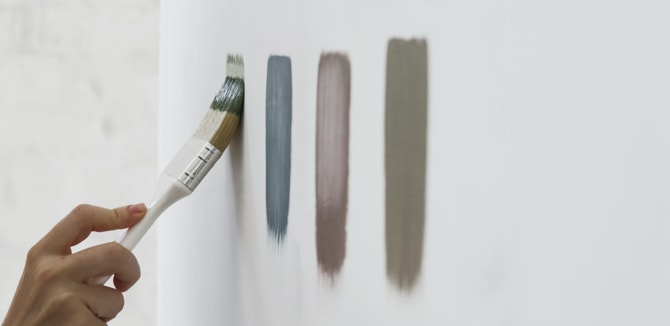
The many different paint types and finishes available:
Latex-based paints
This is a water-based paint that is similar to acrylic in that it is made from acrylic resin. This is a product used often in larger areas and it is flexible, which means it can expand and contract when the temperature changes.
Oil-based paints
Containing linseed oil or a synthetic alkyd oil as a base, this type of paint is usually a more affordable option and offers a high degree of durability. It adheres well to metal and is beneficial to wood. It also should be noted that oil-based paints take a long time to dry.
Textured paints
While it takes longer to mix and apply, textures can be added to paints to provide an interesting look to your surfaces. If you're a fan of faux finishes, textured paint will impress you. It can also be used to hide imperfections.
Flat paints
A shortcut to painting a wall that has numerous imperfections is to use flat or matte paint, which helps to conceal minor blemishes and even some larger imperfections. Flat paint also absorbs more light than glossy paint.
Eggshell paints
Eggshell is the common term used for paint that has a low amount of luster. That isn’t to say that it won’t bounce light off of its surface, because it can achieve that effect without appearing too overly shiny.
Semi-gloss paints
When you think of semi-gloss you should think “satin finish.” If you want something with a little more sheen than eggshell, semi-gloss paint will be the go-to option for you. Light will bounce off semi-gloss much easier than it will off an eggshell finish.
Gloss paints
The most reflective of the paint types, glossy paints have layers of oil or acrylic that will help them shine. When light hits this paint, you will see the light source rather than a scattered effect that less glossy paints will provide.
Need assistance picking out the paint that will fit your needs? At Painters Inc., we’ve worked with all types. We know what will work in your space. We also consider your color preferences to make sure you’re 100 percent happy with the end result.
Types of wallpaper
It’s easy to go down a rabbit hole considering all the different types of wallpaper on the market today. From flowers to stripes, colors that make bold statements to more muted colors for a more discrete appeal – there is something for everyone. The following are some of the more popular options available today.
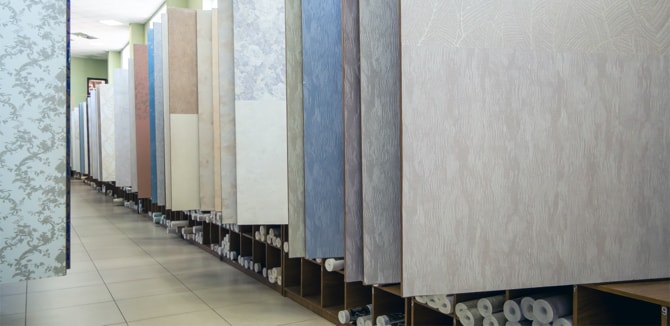
Types of wallpapers:
Lining wallpaper
Often used to smooth out a wall, lining wallpaper is great for when you want a material that will reduce the risk of staining and provide a durable surface for an area that sees a lot of traffic.
Printed wallpaper
Printed wallpaper has a history dating back to the very early 1500s, so it’s a time-honored choice. From elaborate shapes and colors to patterns ranging from trees to flowers and anything in between, printed paper offers a variety of options.
Vinyl wallpaper
Thick, washable and durable, vinyl wallpaper is another popular option that can even withstand steam. Often paper-based, this product is coated with an acrylic vinyl or polyvinyl chloride, which gives it its luster and durability.
Foil wallpaper
Varied and dramatic, foil wallpaper is made from thin metallic foil and it can come in just about any color and pattern. It can really brighten a dark room and add an element of flare that other materials can’t match.
Flock wallpaper
This material re-emerged onto the scene around 15 years ago. Originally popular in the 1600s and derived from scrap cloth to resemble velvet, today’s flock is made from acrylic fibers, but retains the same finish as old flock wallpaper.
Mylar wallpaper
Printed on paper backing, mylar wallpaper consists of a polyester film covering the surface of the paper, giving it durability and wet, shiny appearance. It shares visual similarities with foil paper.
Bamboo wallpaper
A high-end option, bamboo wallpaper has antiseptic qualities, which means it will prevent moss or mildew from growing on it, making it one of the few materials that can be installed in bathrooms and kitchens. It’s an eco-friendly option, yet it is known for its natural beauty.
Obviously, there are many choices you can make. Need assistance choosing the right one for your spaces? Painters Inc. has a history of assisting customers with everything they need, and we can walk you through all your options.
Durability: which lasts longer - paint or wallpaper?
Durability is an important factor for clients that want to have their surfaces painted or hung with wallpaper and want it to last a long, long time. So, which has the most durability?
How durable is paint?
Paint is often recognized as a very durable option and likely the best option for areas that are prone to moisture, but paint doesn’t outlast the lifespan of wallpaper in most situations. Environment plays a big role in how long your paint will last. For example, you’d be more apt to paint bathrooms, which are subjected to a multitude of moisture, with a finishing sheen that helps to repel the water. Painting a bathroom with a matte or eggshell paint would produce less desirable longevity results.
Whether it’s just a fine layer of dust or something more substantial, like a stain, at some point you’re going to have to wipe down your walls and you don’t want to rub off your paint while doing so. Glossy and semi-gloss paint are the least likely to succumb to the pressure of scrubbing. A particularly stubborn stain on a matte finish will probably require “elbow grease” that can lead to the paint rubbing off. For this reason, it’s helpful to keep extra paint on hand so you can make touch-ups as needed.
How durable is wallpaper?
When taken care of, wallpaper can last 15 years or longer. That’s longer than most people will want to keep it, because as trends come and go, wallpaper can be switched out to match what’s relevant or just to provide a “change of scenery.” The good news is that in commercial applications, such as high traffic areas like restaurants and hospitals, recreational buildings and offices, wallpaper can hold up extremely well. The only caveat with wallpaper and its durability is that you should avoid hanging it in areas that receive excessive moisture.
It’s important to choose wisely when you have a contractor either paint or install wallpaper for you, because only the most reputable and trusted contractors will be able to do it in such a way that you get the most out of your choice. And all material types are vulnerable to collision, so if you have high-traffic areas in your home or business, the faster you can have repairs made to your surfaces, the longer they will last.
Maintenance: is it easier to clean paint or wallpaper?
In a perfect world, your surfaces would remain collision free and stain free, but accidents happen. The severity of your problem will depend on the type of paint or wallpaper you have on your surfaces. For example, your vinyl wallpaper is almost always washable, whereas your velvety flock wallpaper could be ruined when introduced to the right type of stain.
So, the more stylish you get with your wallpaper, the less able you will be to knock down dirt, grime and stains. Furthermore, your glossy paint is going to be much easier to clean than an eggshell or matte paint. As a rule of thumb, it’s almost always easier to clean paint than it is to clean wallpaper.
Paints cleaning
It is widely established that most paints are easier to clean than wallpaper, with the exception of textured paint where an aggregate is used, which can be quite difficult to clean compared to something with a sheen, such as a glossy finish. If you have areas of your property that are well traveled and you know they are prone to getting dirty, it is almost always advisable to paint these areas rather than wallpaper.
From easiest to clean to most difficult, the paint types would follow this order: Glossy, semi-gloss, eggshell finish, flat or matte finish. Take this into account when you plan your painting project and let your contractor know which areas get the most use and are at the most risk for becoming dirty.
Wallpapers cleaning
Cleaning wallpaper is more time consuming than cleaning paint. A vacuum with a soft bristle attachment can be used on wallpaper to remove dust and loose dirt, but it will take a different approach to getting stains out. There is a product called “wallpaper dough” that can be rolled across stains to lift them without damaging the wallpaper. Obviously, vinyl wallpaper is going to be easier to clean than flock or wallpaper with a significant amount of texture. In the end, it all comes down to how much traffic you get and your ability to maintain the paper as needed.
Expense: how much does it cost to paint and wallpaper walls?
The biggest consideration in determining cost, whether it’s wallpaper or paint, is the size of the work area. The next consideration is the complexity of the work area; if extensive lift systems are required, that could take more time for setup and to actually get the job completed, which only adds to the expense. However, when talking about the differences in price between paint and wallpaper, paint is the least costly of the two.
Regardless of which one you choose, always bring in a professional contractor with years of experience to do the job, because you will get the most value out of your project with experts doing the work.
How much do painters charge per square foot
The going rate in the Chicagoland area is around 74 cents per square foot for interior painting work. Exterior jobs generally require less prep and fine details, which can knock that price per square foot down to about 65 cents.
So, what are you paying for in each of those 74 cents per square foot, you ask? The bulk of it is going to be labor at roughly 60 cents per square foot. And labor is by far the most valuable component of the services you get from a professional contractor. Anybody can purchase the paints that experts use, as well as the materials that help them safely and efficiently apply the paint, but only the seasoned professionals are able to apply the paint in a way that lives up to exacting standards.
To determine the cost of your project, you could multiply 74 cents by the number of square feet in your facility. For example, you’ve got 4,000 square feet of surface area that requires painting, which would put you at $2,960. But you also have to factor in the complexities of the job. If your facility has a unique architecture that is difficult to maneuver, it will take more hours to physically apply the paint, which can increase the labor costs.
At Painters Inc., our thorough inspection will reveal the true cost of the project, which gives you an advantage when it comes to planning your project.
How much does wallpaper cost per square foot
It costs almost twice as much per square foot to install wallpaper. The industry average today is $1.35 per square foot. So, that same 4,000 square feet of area that could be painted for just under $3,000 would cost $5,400 to wallpaper.
Wallpaper is often a more labor-intensive material to work with, which adds to the expense. You will also pay more per square foot of wallpaper than you will for paint that will cover the same surface area. This helps to account for the drastic difference in cost.
In the end, it all comes down to value – we know our customers want the best outcome for the money and that’s something we’re proud to offer. Furthermore, we never hide any of our fees, which means when you get the final bill, there will be no surprises and definitely no sticker shock. Painters Inc. is competitively priced, yet we offer some of the finest services in Chicagoland.
Paint versus wallpaper: the pros & cons
You’re looking for a change that will liven up your rooms, whether they are offices, corridors, lounges, bathrooms or meeting rooms. You’re entertaining the idea of fresh paint and wallpaper but can’t decide between them. Each could be a stunning addition to your space, but they also have pros and cons attached to them. The following are some of the most mentioned:
- Wide range of colors
- Painting requires significantly less preparation time in comparison with wallpaper
- A painted wall allows you to easily wipe or paint again if you get tired of the original color
- If you are not satisfied with the result, it is easy to repaint
- Paints are a significantly cheaper option in comparison with the wallpapers
- Painting requires a nearly perfect foundation for the results to be good
- It takes longer than you think, many do not think about the number of coats or the drying time in between each coat of paint
- Matt paint is sensitive
- Wide range of designs and textures
- Long-lasting durability
- Visual appeal
- If you have smooth walls already, wallpapering is usually faster
- The cleaning of wallpapers is very easy
- Higher cost
- Difficult removal
- Can peel if used in moist areas
- Some wallpapers can release VOC compounds
Whether you choose paint or wallpaper, you’ll need a trusted expert to do the job for you. Most of our clients choose paint over wallpaper, and we’re going on two decades as the trusted painter in Chicagoland, so when you choose Painters Inc., you’re getting a top-notch contractor working to cater to your every need.
Tips for painting different type of building interiors
The techniques used in painting are universal, but there are subtle differences in how a professional painting contractor will tackle a job based on how the facility is used. For example, the materials and techniques we use to paint warehouses differ from how we approach painting the interior of a restaurant.
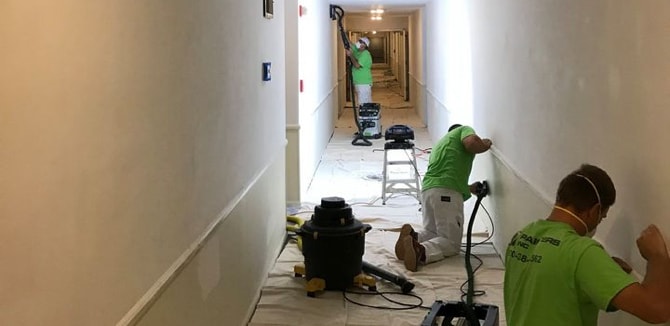
The following are some of the most common commercial buildings we paint and how we approach them.
Office interior painting
Most of our office projects involve a neutral, almost sterile, paint color from Sherwin Williams or Benjamin Moore, such as a muted gray or eggshell white. Components often include trim and baseboards, door jambs and hallways.
Healthcare & medical facility interior painting
Healthcare facilities often require a specific type of paint that has low VOC, which is important given that anything we introduce to the air of surrounding patients must be safe to breathe. Furthermore, this type of work requires extreme attention to detail and a non-disruptive approach.
Restaurant interior painting
Keeping with strict corporate design details is often part of the job with restaurant interior painting jobs. From bright and bold to understated, each restaurant will have its own vibe that we can help to bring out. This is also an industry that requires painting work to be completed during off hours, which is why we offer our services when your doors are closed to the public.
Hotel rooms corridors and hallway painting
Often large projects require multiple painters and a great amount of planning and communication throughout, hotel painting jobs depend on a crew that has speed and equal amounts of efficiency and attention to detail.
Retail shops interior painting
We assist our retail clients in choosing a color or series of colors that will be conducive to consumers shopping there. Aesthetics are important in any painting project, but are vital for retail shops. And while colors are extremely important in this environment, our painters know how to make any color look great by applying them with expertise.
Warehouse interior painting
A skillset held by all contract painters, warehouse painting takes years of experience to master. At Painters Inc., we know which paints and brands hold up to the harsh environment of warehouses and we know how to tackle these jobs so the paint looks great and lasts for years and years.
High-rise building interior painting
Yet another type of building that requires a specific skill set, high-rise painting is among the more difficult to accomplish. At Painters Inc., we use the latest tools to paint the most out-of-reach places, and we do it utilizing our extensive knowledge of safety techniques.
Bank interior painting
The discerning eye of customers at financial institutions hasn’t gone unnoticed. Our banking clients have among the highest standards for the aesthetics in their facilities and we work closely with them to ensure the finest details are covered during the hours that offer the least amount of disruption.
Schools and educational building interior painting
Projects involving academic facilities are among the most varied, offering everything from gymnasium to office painting and classroom to locker room painting. Your contractor has to be familiar with how to handle all of them, which is what we offer at Painters Inc.
HOA apartament interior and hallway painting
Excellent communication is important when you work with an HOA manager. At Painters Inc., we have a proud history of nailing every aspect of HOA painting projects, including hallways, common areas and apartment interiors.
Gyms and fitness centers interior painting
From choosing the right low VOC paints to getting all the color details correct on paint designs that help inspire fitness enthusiasts while they plow through their workouts, there’s a lot that goes into painting these facilities. Fortunately, Painters Inc. is no stranger to completing these projects.
If you don’t see your type of business listed here, don’t worry. At Painters Inc., we’ve assisted clients in just about every industry. Our painters are seasoned professionals ready to prove their knowledge. We will inspect your facility and give you a free estimate that you’ll find competitively priced.
Frequently Asked Questions about painting vs. wallpapering

Making the choice between wallpaper and paint isn’t an easy one. Each option has a set of pros and cons, which must be weighed carefully. At Painters Inc., we get many questions on the topic, so we’d like to share some of the most frequently asked questions here.
Which is better wallpaper or paint?
Beauty is in the eye of the beholder, as the saying goes. If you find paint more attractive than wallpaper, then paint will be “better” for you. The same can be said of one’s preference for wallpaper should they find that more attractive than paint.
However, there are areas where one will be better than the other. For example, we don’t recommend installing wallpaper in rooms that will be prone to excessive moisture, such as the bathroom. An area like this will require a glossy paint that will protect the walls and prevent moisture from becoming an issue.
Is it cheaper to paint or wallpaper?
Generally speaking, it is more affordable to paint than to wallpaper. Wallpaper is a more labor-intensive process, which can drive up the costs, particularly if wallpaper needs to be removed before the new material is placed on the wall.
However, you also have to consider that wallpaper can last roughly three times as long as paint, which means if you don’t foresee yourself changing your wallpaper pattern over the next 15 years (the life of most wallpaper), you will likely have to paint three times over the course of that 15-year period, which means you can actually spend less with wallpaper.
Can you paint over wallpaper?
The short answer is yes, but then you can paint over anything. The question is, should you paint over wallpaper? As a professional painting contractor, our advice is to remove the wallpaper because your paint will look best when it is applied to a flat, flawless surface.
Furthermore, painting over wallpaper increases the risk that the wallpaper will peel away from the wall, buckle or bubble after the paint is applied, which is far from a professional look. Furthermore, should you decide to remove the wallpaper later, the paint on top of it only increases the difficulty of the job.
Does paint brand matter? What are the best paint brands for interior walls?
Experience with paints from different brands has informed our decision on how to approach painting jobs in a variety of situations. We know when a glossy paint should be used instead of matte and vice versa.
We have also narrowed down the top paint manufacturers to two of the most reliable on the market: Sherwin Williams and Benjamin Moore. These companies have a solid track record of researching and developing paints that will look great and last a long, long time.
How do I choose a paint color for my business interior?
If you are held to corporate standards, your options are probably limited, but we can make sure you are in complete compliance with what corporate offices dictate. If you are redesigning and are looking for a change, Painters Inc. can assist you in choosing the colors that will be perfect for the aesthetic you are trying to achieve. We often work off the ideas our customers have and present them with a range of options that ensures they’re getting the exact colors they want.
Get a professional painter for your next interior painting project in the Chicago area
At Painters Inc., our years of service to the Chicagoland area have stood as a testament to our commitment to customers of all types. We bring a knowledge base to our clients, providing the guidance, advice and exemplary services that prove we’re committed to exceeding expectations.
We know that communication is the key to success, so when you contract with us, we work closely with project managers, property managers and owners to ensure that every detail about a job is completely covered. This includes choosing the type of paint and/or wallpaper that will be used in various areas of the property, to prepping the work area, to providing industry-leading installation services. And finally, we do a thorough walkthrough and cleanup, which ensures the property looks far better than it did when we arrived.
If you have questions, contact us and let’s talk about your project.









